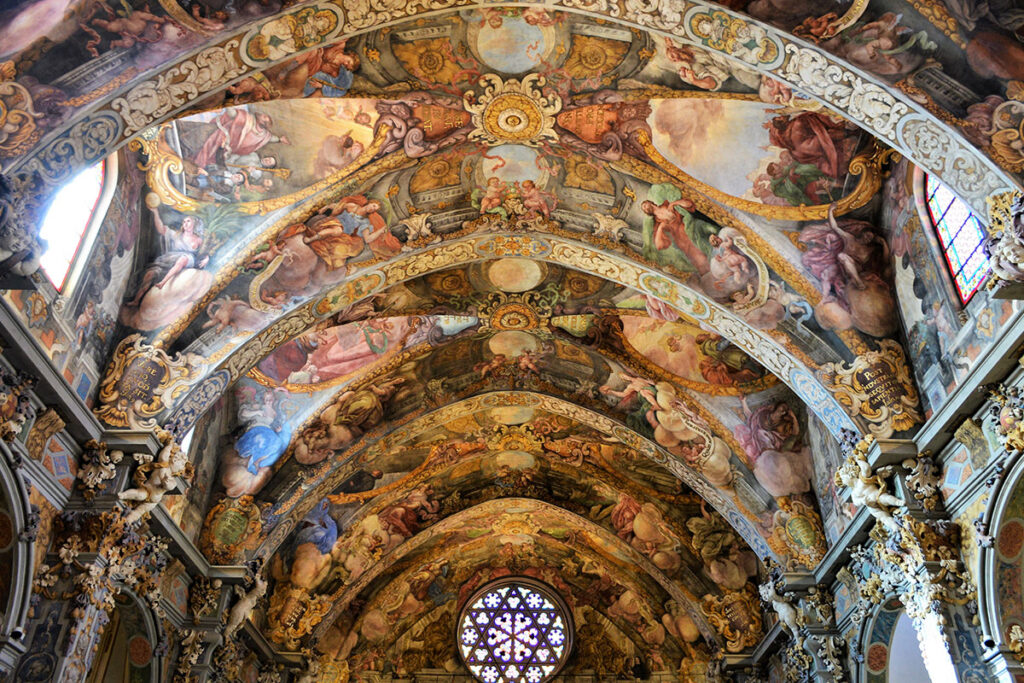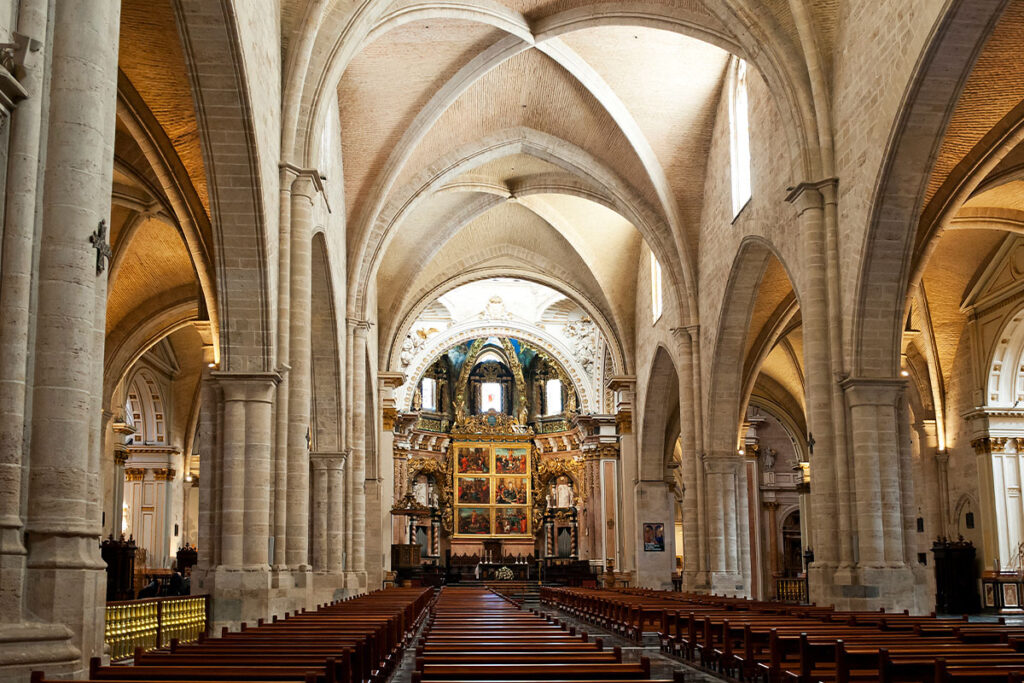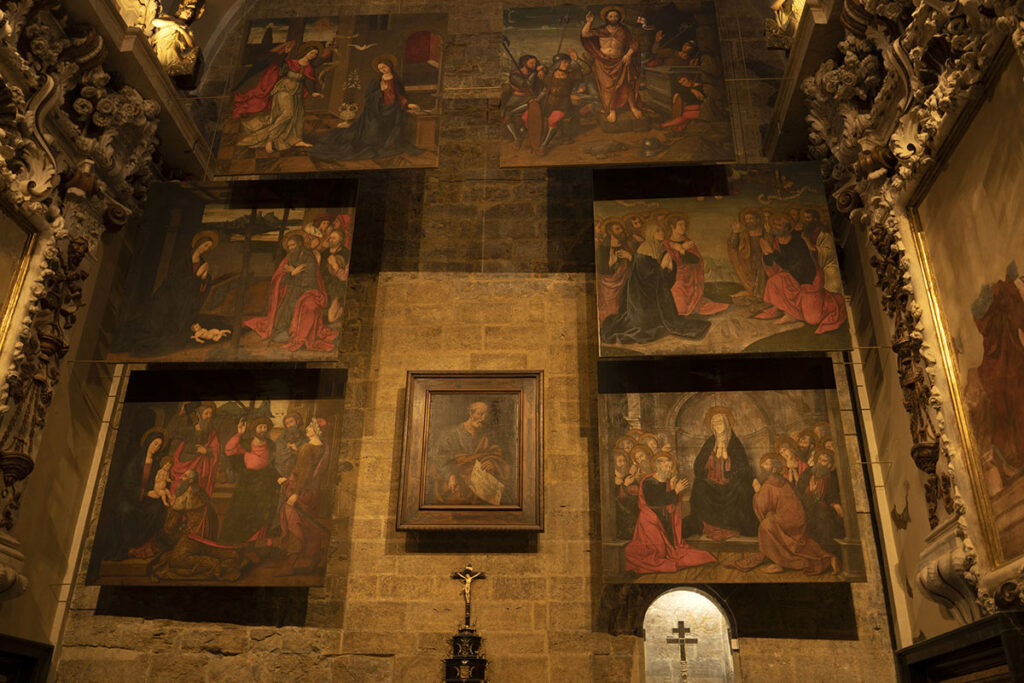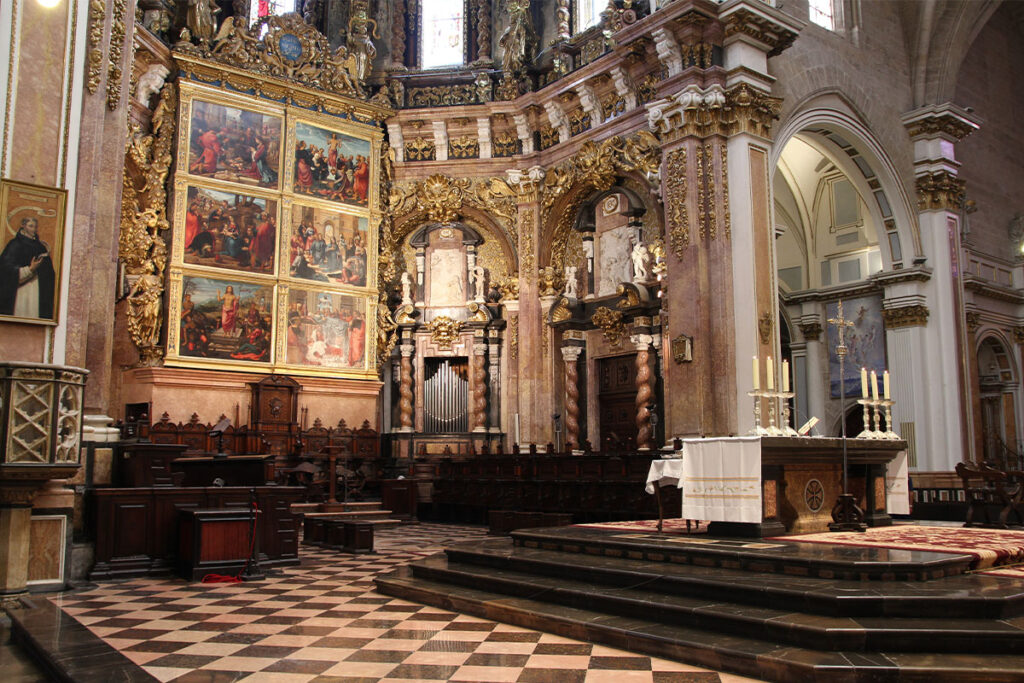Have you ever dreamed of uncovering hidden treasures, marveling at stunning architectural wonders, and delving into the mysteries of a legendary artifact? Valencia Cathedral, an awe-inspiring example of rich history and artistic mastery, offers all of this and more! Join us as we explore the secrets of this iconic landmark, and let your imagination embark on a journey through time.
- Unravel the captivating mystery of the Holy Chalice, rumored to be used by Christ at Last Supper and housed in Valencia Cathedral!
- Explore this architectural marvel with its unique blend of Gothic, Renaissance & Baroque styles + masterpieces from Goya & Frescoes!
- Enjoy extended visiting hours, audio guides in 6 languages & surrounding attractions like Plaza del la Reina for an unforgettable experience!
Unraveling the Mystery of the Holy Chalice
Our journey begins with the enigmatic Holy Chalice, a treasured relic believed to be the Holy Grail, housed in Valencia Cathedral’s Capilla del Santo Cáliz. This remarkable artifact has been shrouded in mystery and legend for centuries, and its presence in the Cathedral adds an element of intrigue and fascination to our visit.
The Holy Chalice, rumored to be the cup used by Christ at the Last Supper, has captured the imagination of countless individuals throughout history. While the Vatican has never confirmed its authenticity, the chalice has been venerated by popes, including Popes John Paul II, during his visit to Valencia in 1982. The story of the Holy Chalice grows increasingly captivating as we delve deeper into the cathedral’s history.
Origins of the Holy Grail
The origins of the Holy Grail are steeped in legend and intrigue, with tales of its storied journey after Saint Peter conveyed it to Rome following the death of the Virgin Mary. Once in Rome, the chalice stayed until the third century. Pope Sixtus II then gave it to his deacon, Saint Laurence, who secreted it away in Huesca during the Roman persecution of Christians.
The Holy Grail’s journey didn’t end there, however. Christians were forced to flee northwards due to the eighth-century Moorish invasion. They took a sacred object with them to the monastery of San Juan de la Peña, located near Jaca. According to historians, the monks eventually presented the relic to King Martín el Humano in 1399. It remained in the possession of the Kingdom of Aragon until 1437 when King Alfonso el Magnánimo passed it on to the Cathedral of Valencia for safekeeping. The allure of this historic and artistic landmark is enhanced by the chalice’s incredible journey and its presence in the cathedral.
The journey to Valencia
The Holy Grail’s passage to Valencia is a tale of adventure and resilience. Although not well-documented, it is believed that the chalice was magically brought to Valencia in 1437 and given to the Cathedral for safekeeping. Key figures in this journey include King Martin I and King Alfonso the Magnanimous, who played crucial roles in bringing the Holy Grail to its final resting place.

The Holy Grail’s arrival in Valencia had a profound impact on the city, shaping its identity and enriching its heritage. Associated with incredible Eucharistic miracles, the Holy Grail holds tremendous cultural importance in Valencia. It was hidden in various places around Spain for 450 years before finally arriving at Valencia Cathedral, a testament to its enduring allure and significance.
Significance and veneration
The Holy Chalice not only holds a prominent place in the history of Valencia Cathedral but also carries immense spiritual significance. Believed to be the actual chalice used by Jesus at the Last Supper, the relic has been venerated by pilgrims and even by Pope John Paul II during his visit to Valencia in 1982.
In the religious practices and ceremonies at Valencia Cathedral, the Holy Chalice plays a vital role. Featured prominently during important religious celebrations such as Holy Week or Corpus Christi, the relic amplifies the spiritual significance of these events.
Continuing our exploration of the cathedral will reveal more fascinating aspects of its history, architecture, and artistic treasures, including the cathedral’s main doors.
Architectural Marvels of Valencia Cathedral
As we make our way through the hallowed halls of Valencia Cathedral, we can’t help but marvel at its architectural splendor. The cathedral’s design is an exquisite blend of Gothic, Renaissance, and Baroque styles, a testament to the skill and vision of the craftsmen who built it.
The construction of Valencia Cathedral began in the 13th century, with each subsequent generation adding their own unique touch to the structure. Delving into the fascinating history of the cathedral’s foundations and discovering the architectural marvels that make this historic building a true masterpiece will be part of our further exploration.
Foundations: From Roman temple to Visigothic Cathedral
Before the creation of Valencia Cathedral, the site was home to a mosque, which had previously been a Roman temple. The Roman temple incorporated various architectural styles, including Romanesque, Renaissance, and French Gothic, reflecting the diverse influences that shaped the region over time.
The ancient Roman temple was eventually converted into a former Visigothic Cathedral, showcasing distinct architectural features such as:
- small scale
- excellent masonry work
- the use of stone vaulting
- the incorporation of horseshoe arches

These early foundations laid the groundwork for the architectural marvels that would come to define Valencia Cathedral, as we’ll see in the following sections.
Gothic splendor: The main building and bell tower
The Gothic splendor of Valencia Cathedral, a gothic style building, is evident in its main building and bell tower, both constructed between 1381 and 1429. The cathedral’s Gothic architecture features an open and horizontal appearance, typical in Valencian Gothic style, with elements such as the Puerta de los Apóstoles showcasing the stunning attention to detail in the design.
The master builders and architects responsible for the Gothic transformation of Valencia Cathedral include:
- Juan Bautista Viñes
- Antonio Gilabert
- Pere Compte
- Antoni Dalmau
Their skill and vision are evident in the cathedral’s awe-inspiring design, which incorporated stones from neighboring quarries in Burjassot and Godella. Our journey will uncover more architectural wonders within the cathedral’s walls.
Renaissance and Baroque additions: Facades and interiors
In addition to its Gothic splendor, Valencia Cathedral is also home to stunning Renaissance and Baroque additions. The High Altar’s breathtaking Renaissance frescoes, for example, showcase the artistic mastery of the time.
Notable architects involved in these additions include José de Vega y Verdugo and José de la Peña de Toro. Their work further enhanced the cathedral’s beauty, incorporating elements from Romanesque, French, Renaissance, and Baroque architecture throughout the structure. Further exploration will uncover additional artistic masterpieces within the cathedral’s walls.
Artistic Masterpieces within the Cathedral
Valencia Cathedral is not only an architectural marvel but also a treasure trove of artistic masterpieces. From hidden Renaissance frescoes to a famous Goya painting, the cathedral’s walls are adorned with breathtaking works of art that showcase the skill and talent of the artists who created them.
One of the most intriguing aspects of the cathedral’s artwork is the depiction of angels playing musical instruments. These celestial beings grace the walls of the cathedral, their heavenly music providing a glimpse into the divine harmony and spiritual transcendence that lie at the heart of the Christian faith. Let’s delve deeper into these artistic wonders and discover the stories behind their creation.
Hidden treasures: The Renaissance frescoes
One of the cathedral’s most well-guarded secrets is its collection of hidden Renaissance frescoes. These stunning works of art, which depict twelve angels playing musical instruments against a starry sky, are considered the first example of Spanish Renaissance art in Valencia.
Commissioned by Cardinal Rodrigo de Borgia (who later became Pope Alexander VI), the frescoes were painted by the talented artists Francisco Pagano from Naples and Pablo de San Leocadio. These hidden treasures, which were restored in 2006, serve as a testament to the incredible artistic heritage of Valencia Cathedral and the skill of the artists who created them.
Goya’s contribution: A famous painting
Another artistic masterpiece gracing the walls of Valencia Cathedral is a famous painting by Goya, titled ‘St. Francis Borgia Helping a Dying Impenitent’. Commissioned by the Duke and Duchess of Osuna, the painting depicts a scene from an 18th-century account and portrays supernatural events in a religious context.
Goya’s painting, which is displayed in the Saint Francis Borja Chapel, showcases the Romanticism style. Employing broad, loose brushwork, vibrant colors, and dramatic chiaroscuro lighting, Goya creates a realistic and expressive scene that is a testament to his artistic genius.

Continuing to explore the cathedral will reveal more incredible works of art, making this historic site a must-see for art enthusiasts and history lovers alike.
Heavenly music: Angels and their instruments
The ethereal beauty of the angels and their musical instruments in Valencia Cathedral’s artwork is a testament to the importance of music in the cathedral’s cultural and religious life. The instruments depicted include:
- Trumpets
- Tambourines
- Zithers
- Organs
- Lutes
- Viols
- Harps
- Shawms
These instruments reflect the musical traditions and practices of the medieval and Renaissance periods.
Painted by Paolo da San Leocadio and other Italian artists commissioned by Rodrigo Borgia, the angelic artwork serves as a stunning reminder of the divine harmony and spiritual transcendence at the heart of Christian faith. Our journey through Valencia Cathedral concludes with a profound appreciation for the incredible artistic and architectural masterpieces that grace its hallowed halls.
Exploring the Cathedral Museum
The Diocesan Museum of the Cathedral of Valencia is an unmissable stop on our tour of the cathedral. Home to over 300 awe-inspiring items of sacred art, the museum offers a fascinating look at the rich artistic heritage of Valencia Cathedral.
Among the museum’s highlights are the world’s largest Corpus Christi Processional Monstrance and a stunning collection of old paintings, including works by Paolo de San Leocadio, Marçal de Sax, and the anonymous Maestro de Alcira. As we explore the museum’s treasures, we gain a deeper understanding of the cathedral’s history and the incredible skill and talent of the artists who contributed to its artistic legacy.
Practical Information for Visitors
Planning a visit to Valencia Cathedral? Here’s some practical information to help you make the most of your experience. The entrance fee for the cathedral includes the use of an audio guide, which is available in Spanish, English, German, Italian, French, and Chinese. Visitors with a Valencia tourist card can also enjoy a discount on the entrance fee.

Visiting hours for the cathedral are from 10 am to 6:30 pm, Monday to Saturday, and from 2 pm to 6:30 pm on Sundays and holidays. To avoid long queues, it’s recommended to arrive early in the morning. You can reach the cathedral by foot, bus (routes 4, 6, and 31), or tram (line 4). For more information on visiting Valencia Cathedral, including audio guide usage and special events, continue reading below.
Audio guide languages and usage
The Valencia Cathedral’s audio guide offers fascinating stories and information about each section of the cathedral, including the chapels and the altar.
Available in multiple languages, including:
- Spanish
- English
- German
- Italian
- French
- Chinese
The audio guide allows you to explore the cathedral at your own pace and immerse yourself in its rich history and artistic treasures.
There are even special audio guides for children, ensuring an engaging and educational experience for visitors of all ages.
Visiting hours and closures
From Monday to Saturday, 10 am to 6:30 pm, and on Sundays and public holidays from 2 pm to 6:30 pm, Valencia Cathedral is open to visitors. The last visit is always 45 minutes before closing, so be sure to plan your visit accordingly. The cathedral may also be closed on certain holidays or have extended hours during the months of April, May, and June to September, so it’s a good idea to check the official website or contact the cathedral directly for the most up-to-date information.
Getting to Valencia Cathedral
Reaching Valencia Cathedral is easy, thanks to the city’s well-connected public transportation system. The cathedral can be reached by:
- Walking
- Taking a bus (routes 4, 6, and 31)
- Using a bike or scooter
- Taking a taxi or private transfer
The exact address of Valencia Cathedral is Plaza de la Reina, 46003, Valencia, Spain, making it easily accessible from various points in the city.
Surrounding Attractions: Plaza del la Reina and Plaza del Virgen
During your visit to Valencia Cathedral, don’t miss the opportunity to explore the surrounding plazas, Plaza del la Reina and Plaza del Virgen, with their vibrant atmosphere and history. As hubs of activity, these iconic plazas are perfect for soaking in the local culture and enjoying a leisurely stroll or a refreshing drink at one of the many cafes and bars.
In Plaza del la Reina, you’ll find monuments and statues such as the Monumento al Medico de Ninos, Monumento A Manolo Montoliu, Monument Al Poeta Teodor Llorente, and Monumento al Rey Jaime I. In Plaza del Virgen, you can marvel at the magnificent El Micalet, the awe-inspiring Real Basilica de Ntra Senora, and the stunning Valencia Cathedral. No visit to Valencia is complete without experiencing the lively energy and historical charm of these two iconic plazas.
Summary
In summary, Valencia Cathedral is a treasure trove of architectural marvels, artistic masterpieces, and fascinating history. From the captivating mystery of the Holy Chalice to the stunning frescoes adorning the High Altar, a visit to Valencia Cathedral is an unforgettable experience. As you explore its hallowed halls, marvel at its Gothic, Renaissance, and Baroque architectural wonders, and immerse yourself in its rich artistic heritage, you’ll no doubt leave with a profound appreciation for the incredible skill and vision of the craftsmen and artists who contributed to this iconic landmark.
Frequently Asked Questions
Why is the Valencia Cathedral famous?
The Valencia Cathedral is renowned for its iconic bell tower, Torre de Micalet, the biggest collection of Gothic bells in Spain and its dedication to history and art since the time of Jaume I. Valued treasures such as frescoes from the Renaissance era and the Holy Chalice are also kept within its walls.
Where in Valencia Cathedral is the Holy Grail?
Head to the Chapel of the Holy Chalice in Valencia Cathedral and discover the official Vatican recognized Holy Grail – crafted of oriental agate stone and nestled in a transparent reliquary!
Is Valencia Cathedral worth visiting?
Valencia Cathedral is a stunning 13th century architectural marvel featuring a mix of Gothic, Baroque and Romanesque styles – an absolute must-see for anyone visiting the city!
Is there a dress code for Valencia Cathedral?
The cathedral does have a dress code, so make sure to dress appropriately before you go! Climb the Miguelete Tower for incredible views of the city as well and don’t forget to check out the Holy Chalice.
What is the Holy Chalice, and why is it significant?
The Holy Chalice, believed to be the holy grail used by Jesus at the Last Supper, adds an element of mystery and fascination to Valencia Cathedral.
Practical info
It’s best to buy tickets to the Valencia Cathedral in advance. You will then avoid standing in a long queue and avoid the risk that all tickets have been sold out, which happens very often in the case of this monument.
- Opening hours: Monday to Friday 10.30 AM to 6:00 PM, Saturdays 10.30 AM to 5:00 PM, Sundays 2:00 PM to 5:00 PM. In April, May and September the cathedral closes at 5.30 PM on weekends.
- Address: Pl. de l’Almoina, s/n, Ciutat Vella, 46003 València, Valencia, Spain
- Buy Tickets on GetYourGuide
Valencia Cathedral on a map
Discover Valencian Community
Each region of Spain is divided into provinces. Their names often coincide with the names of their main cities. Valencian Community is divided into three provinces, each of which has different tourist attractions and interesting places to offer:| Province | Tourist attractions and interesting places |
| Valencia | City of Arts and Sciences (Ciudad de las Artes y las Ciencias), Valencia Oceanarium, BIOPARC Valencia, Mercado Central in Valencia, Turia Gardens, Valencia CathedralPopular cities: Valencia |
| Alicante | Santa Barbara Castle (Castillo de Bárbara), Canelobre Caves, Explanada de España, Volvo Ocean Race Museum, Puerto de Alicante, Terra Mítica Amusement Park, El Peñón de Ifach Natural park, beaches in Alicante (i.e. Playa del Postiguet, Playa de San Juan), Torrevieja (i.e. El Cura, Playa de la Mata, Playa de los Locos), Granadella (Playa de la Granadella) in Jávea.Popular cities: Alicante, Benidorm, Torrevieja, Jávea, Santa Pola, Elche, Villajoyosa, Calpe, El Campello, Altea, San Juan de Alicante, Guardamar del Segura, La Marina, San Miguel de Salinas, Sant Vicent del Raspeig, Pilar de la Horadada, Cabo Roig, Ciudad Quesada, L'Alfàs del Pi, komarka Baix Vinalopó |
| Castellón | Popular cities: Castellón de la Plana |



